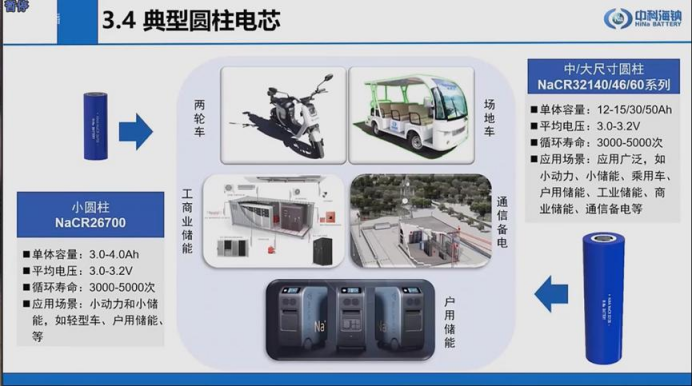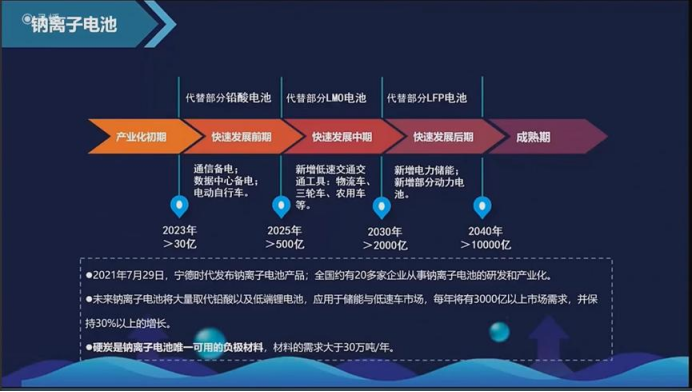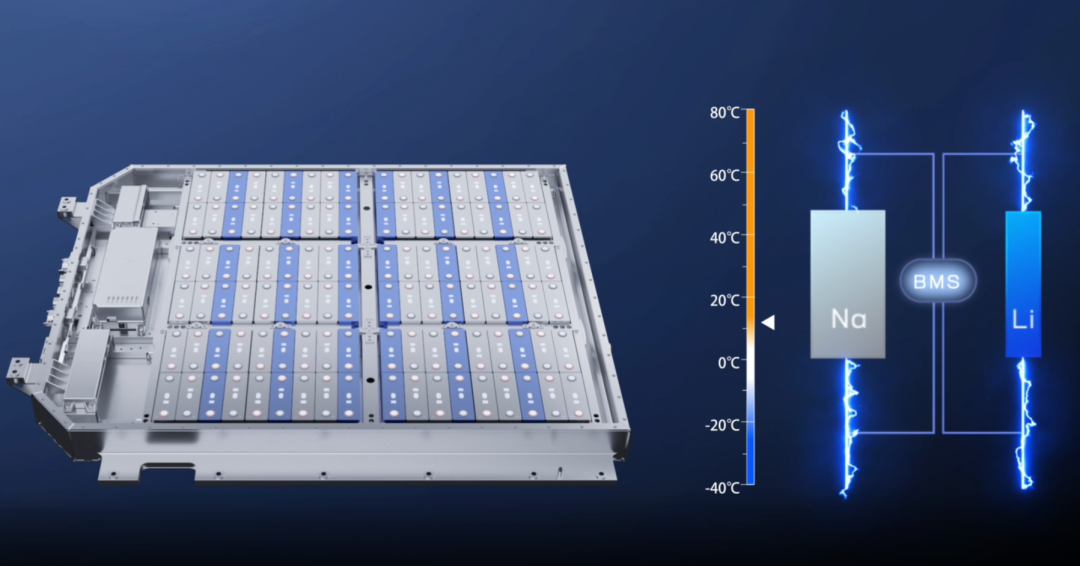Developments and Prospects of Sodium-ion Batteries in High Lithium Carbonate Prices Era
Author: Lingfang Wang
Editor: Kaijun Qiu
In the current scenario of high lithium carbonate prices, the development of sodium-ion batteries has been drawing increasing attention. On November 29th, industry enterprises shared their insights on the current status and future prospects of sodium-ion batteries at the forum on the development of the sodium-ion battery industry chain and standards.
At the forum, Huang Qisen, Vice President of Ningde Times Research Institute, mentioned that sodium-ion batteries generally can only meet the needs of models with a range of less than 400 km. However, with the AB battery structure, the sodium-ion battery can meet the needs of models with a range of up to 500 km, covering about 65% of the market for pure electric passenger cars.
Academician Chen Liquan from the Chinese Academy of Engineering believes that with the improvement of the industrial chain, the maturity of technology, and the scale effects, the cost of sodium-ion batteries is expected to be more than 20% lower than that of lithium iron phosphate batteries.
According to Baisteel’s prediction, the market size of sodium-ion batteries is expected to exceed CNY 200 billion by 2030, and may reach the trillion-level by 2040.
Sodium-ion batteries may surpass lithium iron phosphate in energy density by 2024
Zhongkehai’na, led by Academician Chen Liquan, was one of the earliest companies in China to layout the sodium-ion battery market and has considerable technical and talent reserves. Li Shujun from Beijing Zhongkehai’na Technology Co., Ltd introduced the development of the company’s products.
After deducting the effective capacity of the initial efficiency, the current positive electrode material is about 130 mAh/g, and the negative electrode is about 320 mAh/g, which still has a certain gap compared with lithium iron phosphate batteries.
In terms of energy density, Li Shujun compared the specific energy density as the key index between different types of batteries, because in the field of energy storage, the specific energy density is more important and effective.
The specific energy density of lithium iron phosphate is currently about 360 Wh/L, while that of sodium-ion batteries is 280 Wh/L. The specific energy density of sodium-ion batteries is planned to be increased to 330 Wh/L by 2023, and it is expected to match with the current level of lithium iron phosphate batteries by 2024 while being able to surpass this level in the future.
 Ningde Times has provided clear data on energy density and development goals. The first-generation sodium-ion battery product released by Ningde Times in 2021 has an energy density exceeding 160Wh/kg, and the second-generation sodium-ion battery product will have an energy density of up to 200Wh/kg.
Ningde Times has provided clear data on energy density and development goals. The first-generation sodium-ion battery product released by Ningde Times in 2021 has an energy density exceeding 160Wh/kg, and the second-generation sodium-ion battery product will have an energy density of up to 200Wh/kg.
Cycle life is the advantage of sodium-ion batteries. At present, sodium-ion batteries have a cycle life of about 3000-4000 times. Li Shujun said that with the mass production of materials and batteries, the improvement in stability of materials and cells, and the effective reduction of impurities, the increase of cycle times up to 6000 times is relatively fast, and it can gradually increase to 8000 times and 10000 times.
However, Li Shujun also admitted that the improvement of cycle life is not completely synchronous with the improvement of energy density. Generally speaking, the cycle life of high-energy-density cells is slightly shorter, and the energy density of high-cycle-life cells will also be slightly lower.
Huge Prospects in Energy Storage and Automotive Applications
Because of its good low-temperature performance, stable chemical structure, and greater safety, energy storage will be an important application area for sodium-ion batteries before being used in automobiles.
(1) Energy Storage: Sodium Electrolyte Developed Faster Than Lithium-Ion
Of course, as the representative of the next trillion-dollar market, the development space of sodium-ion batteries is also huge.
According to the prediction of the Zhongguancun Energy Storage Industry Technology Alliance, under the conservative scenario, the total installation capacity of new-type energy storage in 2026 will reach 48.5GW, with a five-year compound annual growth rate of 53.3%. Under the ideal scenario, the total installation capacity will reach 79.5GW, with a compound annual growth rate of 69.2%.
In the view of Tang Liang, the Zhongguancun Energy Storage Industry Technology Alliance, the application of sodium-ion batteries in energy storage may progress faster than the path taken by lithium-ion batteries in the early stage.
Policy-wise, the government has already put forward plans early on. At the beginning of 2022, the National Development and Reform Commission and the National Energy Administration issued the “14th Five-Year Plan for the Development of New Energy Storage Technology,” which clearly stated the need to promote diversified technology development, develop energy storage technologies such as sodium-ion batteries, research and develop new generation high-energy-density energy storage technologies, and carry out demonstration tests of different technical routes, as well as conduct pilot tests on new generation high-energy-density energy storage technologies such as sodium-ion batteries and solid-state lithium-ion batteries.The application of sodium-ion batteries is significant.

Huang Qisen of CATL is optimistic about the development of sodium-ion batteries in the field of energy storage, believing that there is more room for structural simplification and higher storage capacity in system storage. The storage rate is expected to exceed 80%, the cost will be further reduced, and it will better adapt to the continuously subdivided market demand under the carbon-neutral background.
Of course, due to the cost advantages and low-temperature performance, sodium-ion batteries are expected to have more opportunities in the billion-dollar lead-acid market and have a place in the subdivision market of passenger cars and all-weather energy storage market.

(2) Passenger cars: Sodium-lithium hybrid can cover about 65% of the market
The field of vehicle applications is also an area that CATL pays close attention to. In terms of passenger car applications, Huang Qisen believes that sodium-ion batteries can meet the needs of models with a range of less than 400 kilometers. With the AB battery technology created by CATL, the complementary advantages of lithium and sodium can further improve the energy density of the battery system. “The application of sodium-ion batteries is expected to expand to the range of models with a range of 500 kilometers, thereby facing about 65% of the market with broad application scenarios.”

China National Chemical’s sodium product layout includes cylindrical and square cells.
Specifically, small cylindrical 26700 starts from 3Ah and can quickly increase to 3.5-4Ah. Its lifespan is about 3000-5000 times and it is mainly used in small power and energy storage fields.
Regarding medium-size cylindrical cells, China National Chemical’s cylindrical 32140 starts from about 12Ah and then quickly increases to 15Ah. There are also the cylindrical 46 series and cylindrical 60 series in the future, with a single-cell capacity of about 30Ah and 50Ah, respectively, with a lifespan of 3000-5000 cycles.
李树军 believes that the large and medium-sized cylinders will be the main form of cylinders in the future, with a wide range of applications. Besides small power and small energy storage, future products like A00-level passenger cars, household energy storage, and industrial and commercial energy storage may all be the mainstays.

Regarding square cells, Zhongke Haina’s small square series is 27148, with strong versatility, mainly used for small energy storage, including start-up power. The 60160 product is more suitable for household energy storage, industrial and commercial energy storage, and backup power in the communications field.
For large square batteries, the most common one is 72173207, widely used in lithium iron phosphate batteries for energy storage. Sodium-ion batteries may start at 240Ah and then increase to 280Ah or 300Ah, with a cycle life of 5000-8000 cycles, and potential future expansions to over 10000 cycles. They are mainly used in large-scale energy storage, industrial vehicles, and commercial vehicle fields.

李树军 believes that the main product forms for lithium iron phosphate batteries are medium/large-sized cylindrical and square cells.
National policies also strongly support the development of sodium-ion batteries. In April 2021, the National Development and Reform Commission and the National Energy Administration issued guidelines to promote the development of new energy storage, which included sodium-ion batteries, making it the earliest document in China to support the development of sodium-ion batteries. The government has subsequently enacted many supportive policies.
Battery and material companies are placing great hope on the sodium-ion battery industry.
Currently, major domestic battery and materials companies have laid out their plans in the sodium-ion field. Apart from Zhongke Haina and CATL, other companies such as Zhejiang Naichuang, Zenhua New Materials, Rongbai, Dangsheng, and Chengdu BSG have also laid out their plans.
 Billion Electric Grid Corp. boldly predicts that by 2040, the sodium-ion battery market will exceed a trillion dollars.
Billion Electric Grid Corp. boldly predicts that by 2040, the sodium-ion battery market will exceed a trillion dollars.

As shown on the development roadmap of sodium-ion batteries by Li Xiang from Chengdu Billion Electric Grid Technology Co., Ltd., they predict that by 2023, the sodium-ion battery market will exceed 3 billion yuan; by 2025, it will exceed 50 billion yuan, and can partially replace lead-acid batteries, applied in communication backup power, data center backup power, and electric bicycle fields; by 2030, the market size will exceed 200 billion yuan, partially replacing manganese lithium batteries, and initially applied in low-speed electric vehicles; By 2040, they will be applied in the field of energy storage and some power batteries, replacing lithium iron phosphate batteries.
This article is a translation by ChatGPT of a Chinese report from 42HOW. If you have any questions about it, please email bd@42how.com.
